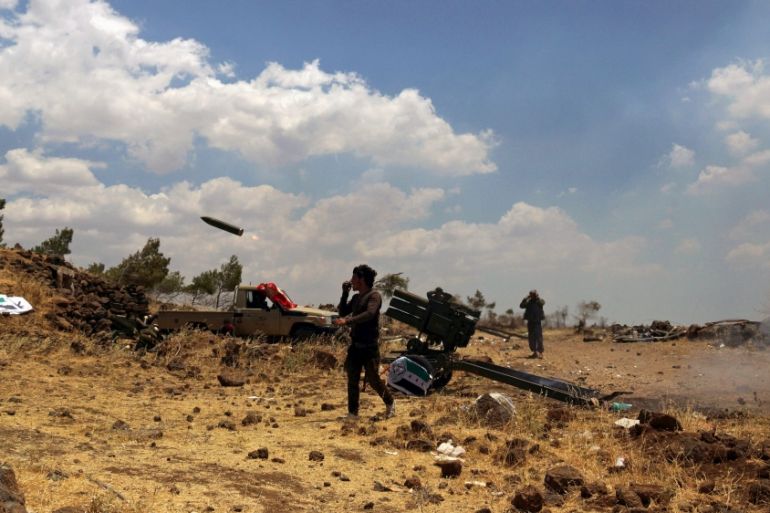Assad forces ‘build up’ troops in Syrian Golan
Syrian government forces and opposition groups battle for control of town’s in strategic Quneitra province.

Fierce fighting between Syrian government forces and armed opposition groups has continued in the Quneitra province of the country’s southwest as locals report a massive build-up of troops and pro-government militias in several towns.
Opposition groups retook Quneitra after the Syrian army briefly controlled it on Saturday, according to the UK-based Syrian Observatory for Human Rights.
The escalation of clashes comes just days after the Syrian government launched a major offensive in the Quneitra province, situated on the border of the roughly 70 percent of the Golan Heights under Israeli occupation since 1967.
|
|
| Hezbollah fighters push towards Golan Heights |
Modar Shanwan, a spokesman for the Revolutionary Command Council in Quneitra and the Golan, a coalition of armed opposition groups, said that government forces “breached [the Quneitra province] down the middle” and were “supported by militias” and artillery bombardments.
“But the revolutionaries recovered control of the Samdaniah village” over the weekend, he told Al Jazeera, referring to a village that the Syrian government had taken over on Thursday. “Assad’s militias [later] tried to sneak back in [and] dozens of them were killed.”
The spokesman also said that government forces had dropped barrel bombs on the area in recent days.
READ MORE: Golan Heights – New flashpoint in Syria war?
In mid-2015, Quneitra-based opposition groups launched an offensive aimed at expelling all government forces from the province. Rebels have expanded their control throughout most of the region.
Yet, the Syrian government has maintained control of two key towns in Quneitra’s countryside, al-Baath and Khan Arnabah, despite rebel groups’ repeated attempts to overrun them.
Abu Omar al-Jolani, a Quneitra-based media activist, said that the Golan’s hilly, rugged terrain “helps the regime” and makes it difficult for opposition groups to advance in Khan Arnabah and al-Baath.
“Controlling this area is important for the regime because it provides a strong line of defence and there is a straight route to the capital, Damascus,” he told Al Jazeera.
On Saturday, the Syrian army and pro-government fighters, including the Lebanese Hezbollah organisation, pounded the Golan-area town of Mashara with shells and rockets as heavy snowfall hit southwest Syria, according to pro-opposition media.
Residents and opposition groups said that government forces are attempting to take over Hamdanieh, a strategic town that rebels have controlled for the last two years.
READ MORE: Medicine in Aleppo, the world’s ‘most dangerous city’
The part of the Golan Heights still under Syrian control has been the target of repeated Israeli air strikes against the government and Hezbollah positions since the conflict started nearly five years ago.
Fawaz Gerges, a Lebanese academic and analyst, explained that the region is “a very important strategic theatre” in the ongoing fighting.
“The loss of Quneitra would be a painful blow to the Syrian government,” he told Al Jazeera. “Since the time of Hafez al-Assad [the former president], the government has made the liberation of the Israeli-occupation Golan a main priority.”
Gerges said that the Golan is part of the Syrian government strategy of “promoting itself as part of the resistance [against Israel]” and throughout the last year “has given Hezbollah and other factions a green light to set up operational bases there”.
|
|
| Syrian rebels resist government offensive |
The ongoing Syrian conflict started as a largely unarmed uprising against President Bashar al-Assad in March 2011, but morphed into a full-blown civil war that has killed more than 250,000 people and turned more than 4.3 million others into refugees, according to statistics by the United Nations.
The Syrian Observatory also reported on Friday that at least 4,600 people, including 1,329 civilians, were killed in Syria’s violence in December.
The monitor estimated that more than 55,000 people were killed in Syria’s conflict in 2015.
“The battlefield is still very much in flux across the country,” Gerges said. “We don’t have a well delineated map of who controls what, or of where the rebel forces exercise control. It changes every day.
“The Syrian government has really fought tooth and nail to maintain a presence in the area, but the rebels have made a major breakthrough by controlling a major chunk of the Golan.”
Follow Patrick Strickland on Twitter: @P_Strickland_